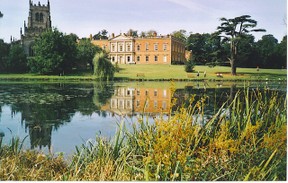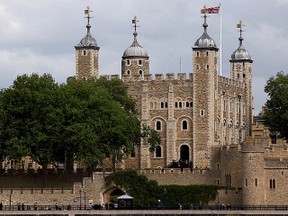 Holy Trinity looks medieval in its construct. The design is a Gothic survival, with some Baroque elements.
Holy Trinity looks medieval in its construct. The design is a Gothic survival, with some Baroque elements.
Buttresses and turrets line the outer walls. Ornate stained glass fills every window and icons stand above the door. The pews are Jacobean. Their cushions, and the altar cloth, are both purple velvet. In short, it looks Catholic, even to modern eyes.
In context, any surviving Catholic traces were being destroyed in every other church in the land. But this wasn't meant to be 'Popish'. It was determinedly and dangerously representing Laudian Anglicanism.
As well as the rebellious inscription above the door of Holy Trinity, there is a second one at the rear. It flanks the battlements around three walls and reads: Sir Robert Shirley Baronet founder of this church anno domini 1653 on whose soul God hath mercy.
He wanted there to be no mistake about who had built the Chapel of Holy Trinity. Nor could the protest message be missed.
Inside the church, the ceiling was painted with English Baroque finesse. All of the elements are represented, as is the Trinity.
The Tetragrammaton is proudly displayed, which is a provocative inclusion. The Name was considered so holy that it could not be shown in Catholicism, nor uttered in Judaism. (As late as 2008, the Vatican issued a directive that Yahweh could not be spoken in liturgy. This controversy isn't confined to the 17th century.)
But Sir Robert Shirley was an avowed Laudian Anglican and there was history with the Tetragrammaton. Archbishop Laud was put on trial in 1642, charged with including Catholic iconography in his own church.
In his defence, he pointed out that a woodcut, from the title page of the Book of Martyrs, featured a Tetragrammaton. It had just been published in a new edition and no-one had blinked about that. He had included nothing worse.
This argument did not save him. He was beheaded on Tower Hill in 1645. But it had been a famous statement, and now Robert had placed the same symbol in his church. That wasn't all. The ceiling art also featured Cromwell as a black dog, poised to pounce upon the Holy Trinity itself.
Around the edges were depictions of the ocean, in waves or sea-shells, which were probably an oblique reference to the exiled King Charles II.
The whole building was enough to have Sir Robert Shirley instantly arrested. That he wasn't showed that the Parliamentarians needed him to be free. Their intelligence agents were watching him very closely indeed.



 My friend and I were starting to think that Leicestershire was a little ashamed of its rebel church.
My friend and I were starting to think that Leicestershire was a little ashamed of its rebel church. Most teenagers think that they have it tough, but Sir Robert Shirley might be forgiven a few moments of quiet reflection.
Most teenagers think that they have it tough, but Sir Robert Shirley might be forgiven a few moments of quiet reflection.

 The over-riding impression of Oliver Cromwell tends to be of a bit of a tyrant. He led a regime which banned everything, while also wrestling government away from the crown.
The over-riding impression of Oliver Cromwell tends to be of a bit of a tyrant. He led a regime which banned everything, while also wrestling government away from the crown.


 The Tower of London has been housing England's political prisoners for nearly 1000 years.
The Tower of London has been housing England's political prisoners for nearly 1000 years.



 By 1653, Sir Robert Shirley appeared to have settled down.
By 1653, Sir Robert Shirley appeared to have settled down.
 Holy Trinity looks medieval in its construct. The design is a Gothic survival, with some Baroque elements.
Holy Trinity looks medieval in its construct. The design is a Gothic survival, with some Baroque elements.


 In December 1653, the gun-runner Rowland Thomas visited Staunton Harold Hall. He wasn't alone. The steward's records show that there were many house guests over the winter.
In December 1653, the gun-runner Rowland Thomas visited Staunton Harold Hall. He wasn't alone. The steward's records show that there were many house guests over the winter. 
 There is an alternative history often told about how Sir Robert ended up in the Tower of London in 1655.
There is an alternative history often told about how Sir Robert ended up in the Tower of London in 1655.


 Being back home gave Sir Robert the opportunity to commission the aforementioned ceiling in his church. He hired two local brothers, Samuel and Zachary Kirk, to paint it.
Being back home gave Sir Robert the opportunity to commission the aforementioned ceiling in his church. He hired two local brothers, Samuel and Zachary Kirk, to paint it.


 By October 1656, the Sealed Knot had risen from the ashes of defeat again. But this wasn't anything to do with Sir Robert Shirley.
By October 1656, the Sealed Knot had risen from the ashes of defeat again. But this wasn't anything to do with Sir Robert Shirley. Sir Seymour Shirley, Robert's nine year old son, became the 5th Baronet of Staunton Harold Hall. It must have felt like history repeating itself, especially as he died in early adulthood.
Sir Seymour Shirley, Robert's nine year old son, became the 5th Baronet of Staunton Harold Hall. It must have felt like history repeating itself, especially as he died in early adulthood.






 St Tydecho's Churches in West Waleson 09/03/2014
St Tydecho's Churches in West Waleson 09/03/2014
 Goodies for an Outlander Premiere Partyon 03/06/2015
Goodies for an Outlander Premiere Partyon 03/06/2015
 Holocaust Memorial Day Interview with Rainer Höss, Grandson of Rudolf Architect of Auschwitzon 01/24/2015
Holocaust Memorial Day Interview with Rainer Höss, Grandson of Rudolf Architect of Auschwitzon 01/24/2015
 Romantic Valentine Gifts for an Outlander Fanon 01/16/2015
Romantic Valentine Gifts for an Outlander Fanon 01/16/2015



Comments
I've only visited that once, but it was a lovely part of the country. I'm going to Leicester next week, so I'll be passing through again. I love the idea of the roundheads, but not the actuality of Cromwell.
I was born in Rugby and visited Ashby-de-la Zouche a few times with my parents as a kid. I was always more of a roundhead at heart- pretty as the royalist villages tend to be.
I'm pleased to have entertained you, Winterfate. <3 Thank you very much for liking and Tweeting it. <3<3
Wow, this is an incredible article Jo! It's obvious that you have put a lot of work into it. Haven't had such a great time reading something in a while. :)
Liked and tweeted!
Kaj - We're such good detectives! Mind you, that inscription was pretty blatant. I'm definitely up for going again, now that I know ALL of the history.
Kate - Pick me up on the way! I want to see that ceiling.
Interesting history, I'm going to add it to the list!
Wow - this is brilliant! You have found out so much more since we went. And it seems we were right - its more of a case of it was built despite Cromwell than done with his permission. So interresting Jo - well done xxx
Win! And please do. :)
I think I start small and clear out the basic terminology first before advancing to such advanced topics ;-) I let you know when the first one is published ;-) SY
If you write one which ties up with this Wizzle, then please do let me know. I'll link it up. There was such a complex ideology surrounding religion at this time, that I don't think you can get where Sir Robert's head was without understanding it. Basically the whole 'what's so different about Catholicism and Laudian Anglicanism?' would be great. Plus one about why the Tetragrammaton was such a provocative inclusion for the ceiling art. :D